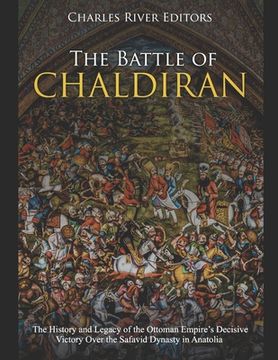The Battle of Chaldiran: The History and Legacy of the Ottoman Empire's Decisive Victory Over the Safavid Dynasty in Anatolia (en Inglés)
Reseña del libro "The Battle of Chaldiran: The History and Legacy of the Ottoman Empire's Decisive Victory Over the Safavid Dynasty in Anatolia (en Inglés)"
*Includes pictures*Includes a bibliography for further readingThe town of Caldiran (Chaldiran) in Turkey is home to about 60,000 people. On a plain close to the Iranian border, it it backdropped by the Armenian Ranges and very close to a Faultline, which has ensured it's suffered from seismic activity many times in the past. But in the early 16th century, it was the site of different kinds of faultlines, serving as a battleground between the region's two greatest powers as they clashed over politics and religion. In the wake of taking Constantinople, the Ottoman Empire would spend the next few centuries expanding its size, power, and influence on the way to becoming one of the world's most important geopolitical players. It was a rise that would not truly start to wane until the 19th century, and while its most memorable conflicts were fought against the Europeans, the course of Ottoman history was greatly impacted by events against the other major Muslim power in its region: the Safavid Empire.Naturally, the two powers quickly took up the geopolitical positions of the old Byzantine and Persian Empires in the time before Islam and fought over much of the same territory, including Mesopotamia, the Caucuses, today's eastern Turkey and the Persian Gulf. Their first battle was fought in 1514, their first real war was fought from 1532-1555, and they continued to spar regularly until the early 19th century, when European colonialism forced them both onto the defensive. Echoes of these conflicts can be seen in the recent sparring between Iran and Turkey through proxies in Iraq and Syria.On August 23, 1514 the two sides clashed at Chaldiran in a contest for hegemony over the Middle East, and the results have affected the Middle East ever since. Regrettably, few concrete details of the actual battle survive, a not uncommon obstacle when studying battles from the Middle Ages. However, the course of the conflict can be reconstructed from the politics of the time, knowledge of the characters involved, the contemporary records are available, and what followed the battle. There is no lasting monument to the battle in Chaldiran on site, but there is on the Iranian side of the border, nearly 20 miles to the east near the village of Gala Ashaki. It consists of a domed tomb for a Persian general, Sayyed Sharif-al-Din Ali Shirazi, who fell in the battle. He was the chief religious cleric of Shah Ismail I, the first of the Safavid rulers of Persia and a leader who brought a monumental religious shift to the Middle East. Believing himself the "Shadow of God" and his chosen vessel, he set about transforming Persia and the globe through his fanatical religious militia, the Qizilbash. He meant to lead not only Persia but the entire Islamic world, but this vision was vehemently opposed by Sultan Selim I of the Ottoman Empire. Selim the Grim had fought tenaciously for possession of his throne, and he too believed himself chosen by God to rule all Muslims.The battle is depicted in a magnificent painting in Sayyed Sharif-al-Din Ali Shirazi's tomb. In the foreground of the representation, Shah Ismail I of Persia leads his Qizilbash in a charge against the Ottoman cavalry, riding over the corpses of the slain. In the middle, Sultan Selim (who did not actually participate in the battle, though he was present) leads an almost leisurely advance toward the Persian cavalry, preceded by two Janissaries armed with axes. In the background, the Ottoman artillery delivers a barrage into the Qizilbash, who are falling or fleeing. It seems to be a chronological depiction of the conflict, and though the figure Ismail is clearly the centerpiece, there is no attempt to mask the fact that the battle was a catastrophic defeat for the Persians.

